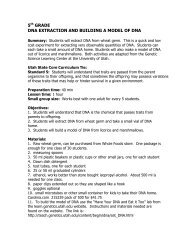class science fair project - Beacon Heights Website
class science fair project - Beacon Heights Website
class science fair project - Beacon Heights Website
You also want an ePaper? Increase the reach of your titles
YUMPU automatically turns print PDFs into web optimized ePapers that Google loves.
2 ND GRADECAN WE PHYSICALLY CHANGE THE SHAPE OF AN OBJECTAND MAKE IT FLOAT?CLASS SCIENCE FAIR PROJECTSummary: Students will work together as a <strong>class</strong> to generate a <strong>science</strong> <strong>fair</strong><strong>project</strong>. The students will use the steps of the scientific method to ask aquestion, make a hypothesis, design a test, collect data, and draw conclusions.Their findings will be presented to the <strong>class</strong> and placed on a <strong>science</strong> <strong>fair</strong> <strong>project</strong>board for the school <strong>science</strong> <strong>fair</strong>. The topic of this <strong>project</strong> is to find out whetherstudents can construct a shape out of clay that will float.Utah State Core Curriculum Tie:Standard 1: The process of <strong>science</strong>, communication of <strong>science</strong>, and thenature of <strong>science</strong>Objective 1: Generating EvidenceObjective 2: Communicating ScienceObjective 3: Knowing in SciencePreparation time: 30 minLesson time: 50 minSmall group size: works best with one adult for every 5 studentsMaterials:1. tub filled with water at each table2. 2” - 3” ball of clay for each student, this can be reused if not left in the water3. several half sheets of paper per group4. one <strong>science</strong> <strong>fair</strong> presentation board5. headings made for the presentation board: why we did this, what we thinkwill happen, how we did it, what we saw, what we learnedObjectives:1. Students will conduct an investigation that follows the scientific method.2. Students will submit a <strong>class</strong> <strong>project</strong> to the school <strong>science</strong> <strong>fair</strong>.3. Students will perform an experiment and observe whether they can constructan object out of clay that will float.Background information:A ball of clay will sink in a tub of water because the density of the ball ishigher than the density of the water. However, if that same ball of clay ischanged into a shape that has it’s mass more spread out over a larger area, itsdensity will decrease. If the new structure has a density lower than water, this
shape will float. Usually forming the ball of clay into a boat or pancake shapewill cause it to float as long as water doesn’t creep into the structure and sink it.Pre-lab discussion: Show the students a ball of clay and ask them if theythink it will sink or float. Place the ball into a tub of water and observe theresults. Ask for ideas on what they could do to the ball of clay to get it to float.Explain to them that they will experiment on what shapes of clay sink and whichshapes float. Discuss with the students what a <strong>science</strong> <strong>fair</strong> is and tell them thatthey will complete a <strong>science</strong> <strong>fair</strong> <strong>project</strong> today in the <strong>class</strong>room.Instructional procedure:I. Experiment: Complete the experiment first and then work on writing theassigned sections for the <strong>project</strong> board.1. Have students make a clay ball about 2” – 3” in circumference. They shouldpredict what will happen when they drop the ball into the water. They shoulddrop the clay ball and then observe their results. ** Be sure and remove theclay ball from the water immediately after dropping it in and lightly dry it off withpaper towels. Repeat this each time you drop the clay into the water.2. Have each student predict a shape they think will float. Students should thenmake their shape. After they place their shape in the water they can observe if itsinks or floats.3. Students should make a drawing of their shapes and separate them into twogroups: sink or float.II. Science <strong>fair</strong> display board: Assign each group a different section of the<strong>class</strong> <strong>science</strong> <strong>fair</strong> display board. Each group can decide what to write and thenhelp the students take turns writing the different words on a half sheet of paper.Students will write up their section and then place it in the appropriate area onthe display board. If you take pictures of the students working on the <strong>project</strong>you can put them on the board as well.



